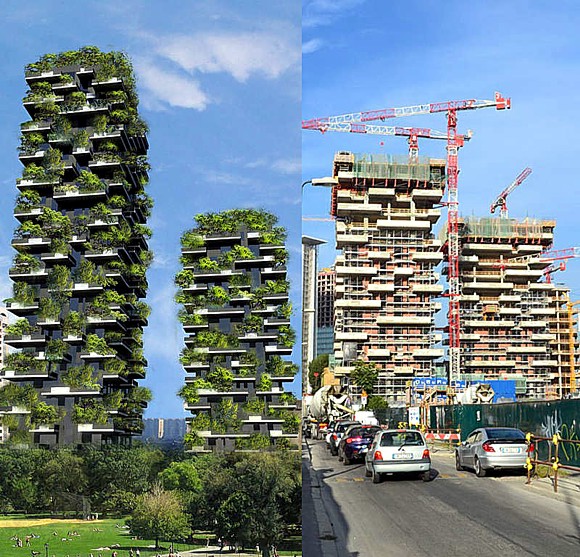Milan Vertical Forest Residential Towers Getting Accolades For Pollution Reducing Eco-Design
 January 26, 2015
January 26, 2015  Kyriaki (Sandy) Venetis
Kyriaki (Sandy) Venetis Stefano Boeri, architect of the newly completed Bosco Verticale Towers in Milan, is receiving a lot international attention for a living-green design that’s expected to create a healthier environment for both the two towers’ residents and the city as a whole.
 Bosco Verticale Towers in Milan. Photo courtesy of Plascon Trends.
Bosco Verticale Towers in Milan. Photo courtesy of Plascon Trends.
While Milan is known for being one of the most elite fashion capitals in the world, it also has a less flattering reputation for being one of the most polluted cities as well.
As TIME Magazine put it, Milan is a traffic-heavy city with “toxic smog that is so bad that some reports have pegged the city as the pollution capital of Europe.” The magazine profiled the project, calling it “an experiment of cohabitation between trees and people,” and hopes the new towers are a beginning step toward measures to improve the air quality in the city.
Designboom Architecture eloquently describes the towers, saying the facades are lined with staggered concrete balconies which have become planting boxes for the various trees, shrubs, and plants.
The towers, reaching a height of 367 ft. and 262 ft. respectively, feature a combined 800 trees, as well as about 4,000 shrubs and 14,000 plants.
Designboom describes some of the benefits this green design, saying each apartment has “a personal garden which buffers the interior spaces from acoustic pollution, dust particles, harsh winds, and direct sunlight.”
Among other benefits, Designboom adds that the “leafy canopies absorb carbon dioxide and breathe oxygen into the homes as well as fresh air” and grey water from the buildings is filtered and reused for irrigation of the extensive vegetation, while photovoltaic systems contribute to the self-sufficiency of the complex.
Boeri told The Guardian that this project required an interdisciplinary team including botanists and engineers to test the wind resistance of different species of trees in wind tunnels. Deciduous trees (which shed their leaves every autumn) were selected for the project.
In the summer months, Boeri also told the Guardian that the residents’ aesthetic needs will be met by having the trees maintained and trimmed so foliage doesn’t interrupt their views.” He also said that complex’s biological architecture will have the job of absorbing dust from the air, in addition to creating a micro-climate that filters out excess sunlight.
Jill Fehrenbacher, founder of Inhabitat and a LEED-AP green designer, also similarly expounded to The Guardian the benefits of the design, saying, “Living plants clean the air and produce oxygen, they help humidify indoor air, they reduce storm runoff and the urban heat island effect, and they help insulate a building.
“Even though skyscrapers like the Bosco Verticale inherently use a ton of resources and energy – simply by virtue of being a high-rise – all those trees and plants are going to be beneficial to the building occupants, neighbors, and local environment.”
There is also one additional benefit – the cost. According to la vita del design, “The construction of the towers cost 65 million euros, just five percent more than an average skyscraper, and the project’s vertical design provides space that is equal to a large area of urban sprawl. The structure sets a precedent not only for new developments in Milan, but also for similar cities with the same level of urbanization.”
In worldwide recognition, last November, the towers received the bi-annual International Highrise Award from the Frankfurt Museum of Architecture, beating out 800 other buildings erected over the last two years for the honor.

Reader Comments